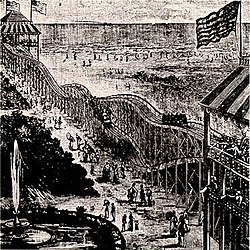Switchback Railway: Difference between revisions
Citation bot (talk | contribs) m Alter: title. | You can use this bot yourself. Report bugs here.| Activated by User:Chris Capoccia | Category:Pages with citations having bare URLs. |
Epicgenius (talk | contribs) |
||
| Line 46: | Line 46: | ||
[[Category:Coney Island]] |
[[Category:Coney Island]] |
||
[[Category:Former roller coasters in New York (state)]] |
[[Category:Former roller coasters in New York (state)]] |
||
[[Category:Demolished buildings and structures in Brooklyn]] |
|||
Revision as of 19:03, 25 April 2020
| Switchback Railway | |
|---|---|
 The original Switchback Railway at Coney Island | |
| Coney Island | |
| Location | Coney Island |
| Park section | Coney Island Cyclone Site |
| Status | Removed |
| Opening date | June 16, 1884 |
| General statistics | |
| Type | Wood |
| Manufacturer | LaMarcus Adna Thompson |
| Designer | LaMarcus Adna Thompson |
| Model | Lift Packed |
| Track layout | Gravity pulled coaster |
| Lift/launch system | gravity |
| Height | 50 ft (15 m) |
| Drop | 43 ft (13 m) |
| Length | 600 ft (180 m) |
| Speed | 6 mph (9.7 km/h) |
| Duration | 1:00 |
| Max vertical angle | 30° |
| Capacity | 1600 riders per hour |
| G-force | 2.9 |
| Switchback Railway at RCDB | |
The original Switchback Railway was the first roller coaster at Coney Island and one of the earliest designed for amusement in America. The 1885 patent states the invention relates to the gravity double track switchback railway, which had predicated the inclined plane railway, patented in 1878 by Richard Knudsen. [1][2][3] Coney Island's version was designed by LaMarcus Adna Thompson in 1881 and constructed in 1884.[4] It appears Thompson based his design, at least in part, on the Mauch Chunk Switchback Railway which was a coal-mining train that had started carrying passengers as a thrill ride in 1827.[5]
For five cents, riders would climb a tower to board the large bench-like car and were pushed off to coast 600 ft (183 m) down the track to another tower.[5] The car went just over 6 mph (9.7 km/h).[5] At the top of the other tower the vehicle was switched to a return track or "switched back" (hence the name).
This track design was soon replaced with an oval complete-circuit ride designed by Charles Alcoke and called the Serpentine Railway.[5] In 1885 Phillip Hinkle developed a lift system which appeared in his ride called Gravity Pleasure.[4] The Gravity Pleasure also featured cars in which the passengers could face forward instead of in the awkward bench-like seats of the first two roller coasters.[5] Not to be outdone, in 1886 LaMarcus Adna Thompson patented his design of coasters that included dark tunnels with painted scenery.[4] Thompson built many more roller coasters across the country which were called "The L.A. Thompson Scenic Railway".[5] Some of these operated until 1954.[citation needed]
Other rides
There was also a switchback railway at the Melbourne Centennial Exhibition in 1888.[6]
References
- ^ "US Patent No. 332,762 Patented". Google Patents. December 22, 1885. Retrieved June 16, 2018.
- ^ "Improvements in inclined-plane railways". Google Patents. January 1, 1878. Retrieved June 16, 2018.
- ^ "History of Roller Coasters: The Switchback Railway, America's First Roller Coaster". Entertainment Designer. October 16, 2011. Retrieved June 16, 2018.
- ^ a b c Urbanowicz, Steven J. (2002) The Roller Coaster Lover's Companion, Citadel Press Kensington, New York. ISBN 0806523093. pg 4.
- ^ a b c d e f Rutherford, Scott (2000) The American Roller Coaster, MBI Publishing Company, Wisconsin. ISBN 0760306893.
- ^ The Argus. Melbourne. 21 July 1888. p. 11 http://nla.gov.au/nla.news-article6895338. Retrieved 14 February 2013 – via National Library of Australia.
{{cite news}}: Missing or empty|title=(help)


